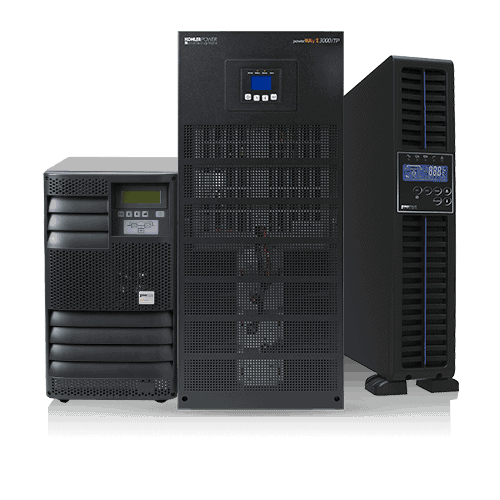Data centres by nature contain information and communications technology (ICT) equipment whose uninterrupted operation is vital to the centres’ users. A sudden loss of power or voltage spike can permanently damage ICT equipment or wipe out data; such events have been known to close businesses down. With these realities, a carefully specified UPS system becomes an essential part of the data centre infrastructure. The challenge is to strike an optimal balance between energy efficiency, reliability, overall power performance and lowest total cost of ownership while meeting the particular requirements of the data centre environment.
How data centres challenge UPSs
One of a data centre’s most obvious aspects is its size, with total power demand sometimes running into megawatts. On these large scales, efficiencies become critical because of their implications for Green issues, energy management, costs and cooling considerations. As already mentioned, protected, reliable power is critical for data centre operation, so the UPS must provide this protection while remaining completely reliable and available itself, in terms of both its electrical and battery systems. If the UPS does detect any actual or latent problems, it must be able to communicate information about these immediately.
Centres tend to be densely populated, with real estate at a premium as each server adds revenue-earning capacity. They are also dynamic environments, often with growing processing loads that call for increases in power capacity during operational life. The load’s critical nature also means that back-up generators are often considered essential to assure a continued power supply if a mains failure event exceeds the UPS battery autonomy.
Blade servers have become steadily more popular in these environments because of their flexibility and power density. However, they present leading power factor loads that can create problems for UPSs not designed to handle them. Total Input Harmonic Distortion, if not held to a low level, can create a need for oversized equipment and cabling, increase heating and waste energy in input transformers, and reduce input component lifetimes.
Meeting the data centre power challenge
As data centres have grown to present the challenges above, UPS technology has evolved to meet them. Accordingly we can look at how to choose a UPS with the technology, configuration and capacity needed to optimally protect the data centre it serves.
A fundamental UPS technology choice is between online and offline systems. Offline systems offer an apparently cheaper alternative. During normal operation, these pass electrical power directly from the raw mains input through to the critical load. If the mains fails, the UPS turns on the inverter and power is drawn from the battery. Although such systems are used in some applications for economic reasons, they have two critical drawbacks for data centres. Firstly, the critical load is exposed to raw mains during normal operation, with no protection from electrical spikes or other disturbances that could damage the site’s ICT equipment. Secondly, there will be a break of up to 10 mS during any changeover between battery and mains operation. For ICT equipment, this is unacceptable and negates the purpose of installing a UPS.
By contrast online systems permanently pass power from the mains through their rectifier/inverter chain to the critical load. The UPS battery floats on the rectifier/charger output and continues to supply power without a break if the mains fail. The critical load is always fed with processed power, which protects it from mains borne noise and transient voltage excursions as well as providing a well-regulated output voltage. Also, online solutions have been further enhanced by the advent of transformerless design.
Transformerless design replaces earlier, transformer based phase-controlled rectifiers with solid-state systems that use Insulated Gate Bipolar Transistor (IGBT) devices, resulting in UPSs that are considerably reduced in size and weight, as well as being more efficient. For example, a transformer-based 120kVA unit with a footprint of 1.32 m² and a weight of 1,200 Kg can be replaced with a transformerless implementation weighing 370 Kg and occupying a 0.53 m² footprint. Efficiency also improves by about 5% across the entire load spectrum. UPS systems with efficiencies up to 95.5% and low penalties for partial loading are now possible, even with MVA-rated configurations. These improvements in efficiency contribute significantly to reducing data centres’ energy consumption, because energy demands for cooling as well as for feeding the critical load are reduced.
The reduction in footprint has obvious benefits in space-critical data centre environments. Good UPS design can boost this advantage by ensuring that only front access is needed for installation and servicing. Further, less obvious, but equally important benefits also arise; availability and scalability. The reduced dimensions mean that modular transformerless units become practical. Therefore, scaling to meet a growing data centre’s increased demand for protected power capacity can be done easily by incrementally adding UPS modules. Overall UPS availability can be improved with an N+1 configuration, in which N represents the number of modules required to fully support the critical load. In such a configuration, the failure of a single module becomes invisible to the load.
Scalability and availability can now be achieved at the higher power levels needed by larger data centres. For example the KUP KOHLER PW 6000 family has units rated from 60kVA to 500kVA that have internal redundant critical circuits to maximise system reliability and load availability. Up to 10 units can be paralleled together to give up to 5MVA capacity on an N+1 configuration. As with the smaller modular systems, capacity can be incremented unit by unit as required.
When assessing the present and possible future requirements for a data centre UPS installation, it is important to consider the nature as well as the size of the critical load. If this includes leading power factor blade servers, the UPS ability to manage these without derating must be known and allowed for in capacity sizing calculations. Similarly, the UPS’s ability to control and reduce harmonics must be known, as this affects equipment and cable sizing, component lifetimes and input transformer heating.
Issues of scalability, availability, size and capacity affect UPS batteries as much as the UPSs themselves. If the mains fail, the battery capacity in Ah must be sufficient to support the critical load for the required autonomy – the time for which the batteries must reliably deliver full power. Battery cells must be wired in serial strings to provide the required output voltage, but this means that the failure of one cell disables the entire string. However battery strings can be connected in parallel, either to build N+1 configurations or to increase capacity.
The UPS’s communications ability is also essential to its viability. If the UPS detects a mains failure, and decides that its duration warrants further action, then it must inform related equipment as well as human operators accordingly. This signal should also be available to the critical load, allowing it to shut down gracefully within the battery autonomy if no generator is present.
Today’s UPS communications functions can provide more detailed and valuable information that can be transferred onto the site’s network and made available in real time wherever it is needed. This data can be represented within a web brower, or utilised by customer building management systems. On larger sites with multiple UPS installations, communications capability is essential to allow management of the UPS units at a system level.
Conclusions
The above shows how UPS systems can be optimised for data centres’ particular demands. Online, transformerless technology ensures continued, protected power during mains disturbances or breaks, delivered by a system offering good power efficiency from a compact footprint. Scalability to meet data centres’ changing demands, and availability through N+1 redundancy can be provided through an incremental, modular approach, even on large systems up to 5MVA. Flexible battery configuration and sizing is also possible. Sophisticated communications features, safe shutdown of critical loads, and UPS monitoring and control. Modern UPS technology with its efficiency of operation achieves this level of protection cost-effectively, efficiently and with a low carbon footprint.




